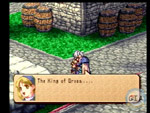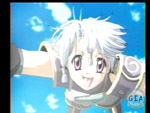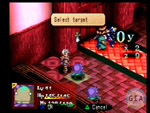
 |
|
Developed by Sunsoft, and planned for release by the now-defunct American branch of the company, Eternal Eyes has been picked up and released by Crave Entertainment well after the title was thought to be dead. Overall, the title is nothing all that different; the game is a tactical RPG containing its own form of collectable monsters, with anime cutscenes sprinkled throughout. The story centers around a boy named Luke who discovers that he is one of the last decendants of a tribe named the Crimson Eyes. Naturally, this is the only tribe that can stop the forthcoming resurrection of the goddess of destruction, Luna. Luke gathers his band of friends to help stop Luna from being resurrected, though quickly finds out that his friends actually aren't going to help him fight, but just provide someone for him to talk to during cutscenes. Instead, Luke is assisted by up to three living puppets.
It is these puppets, also known as Mappemon, that the game is primarily centered around. Luke will receive featureless, lifeless puppets from time to time in the game, and can animate them using one of 24 different kinds of jewels. The kind of creature the puppet turns into is determined by which of the 24 kinds of jewels you use to breathe life into it. These creatures vary widely in look, ability, and power; everything is available from the large hulking brutes known as Nightmares to the typical cute sidekick-looking Mooscues. Once a Mappemon gets to certain levels, Luke can evolve basic Mappemon, such as a Mooscue, into more advanced monsters using specific (and unstated) combinations of jewels. However, while there is a wide variety of monsters available, getting the Mappemon that you desire is another topic altogether: evolutions from one Mappemon to another seem very random, and it is not at all uncommon to have a battle-heavy monster evolve into a magic-using monster that does single-digit damage. This makes distributing spells (also acquired by using jewels) extremely difficult, especially given the rarity of certain colors and types of jewels. To top that, evolving puppets in the later stages of development becomes nearly impossible without the help of an evolution guide; puppets require specific chains of jewels to be used on them (up to four for the final evolution), and the game does not help you figure these chains out in the least, leaving you to trial and error, along with many reboots.
As far as the battle engine in Eternal Eyes is concerned, anyone who has played Final Fantasy Tactics or Tactics Ogre knows what to expect from the title. Battles take place on a grid, and tend to be weighted 2-to-1 in favor of the enemies. All of the player's characters take a turn, which consists of walking and/or performing one action. Once they are all done, the enemies take their turn, and the game repeats. While this system can be wonderful when used correctly, this is not the case with Eternal Eyes. Granted, the battle system is not bad, it just lacks the tweaks and fine-tuning that made the aforementioned games so great. Attacking from the side, back, and front all do the same amount of damage, and players can generally just heap puppets with high-damage equipment so that they can simply wail on the enemies. Very little magic is needed in the game, and tends to be used only when the puppet cannot get in range of the enemy. Luckily, the game does have quite nice graphics. Each monster, puppet, and character is a hand-drawn sprite with well-done animation, and each character that talks gets a nice big anime-style head in the dialogue box. Likewise, each of the major cutscenes has an accompanying anime-style still that helps portray the action that is occurring. Unfortunately, stills are all that the game has, save for the opening movie. Given the quality of the stills, full anime cutscenes would have been wonderful, and considering that the game was a full-price title in Japan, it is somewhat of a surprise that the game lacks this. Likewise, the game can't match up to other sprite-based games as far as in-game graphics go. However, when the game is compared to other budget titles in this department, it truly shines.
The game does contain many middle-of-the-road areas as well. The game's score is rather forgettable, though is rarely grating, and the translation is solidly done, if awkward at times. Likewise, the interface is decent and easy to navigate, though menu configuration will cause many gamers to enter status screens when they are trying to end the turn. The towns, all two of them, tend to be rather confusing to navigate thanks to bad camera angles, but Sunsoft has chosen to include a very handy Move command that lets you jump from building to building. Throughout the game, Sunsoft and Crave walk a fine line of mediocrity, and you are left with the feeling that with just a week or two more in development the game could have truly shined in many of these areas. Though many will dismiss it as just another budget title, Eternal Eyes is easily worth the price, and gamers either without next-gen systems, or those who love tactical-RPGs will find lots to enjoy them over here, especially since the game does offer a bit of replay value. However, with so many other quality titles out there, many will find that their $9.99 would be better spent elsewhere. Review by J.T.Kauffman, GIA. |
| |||||||||||||||||||||||||||||||||||||||||||||||




